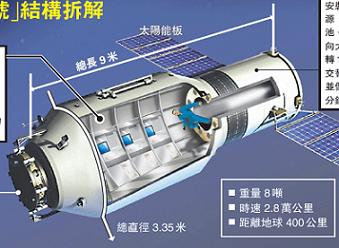The Tiangong-1 (Heavenly Palace 1 in Chinese) was the first space station launched by China. It was carried into orbit in September of 2011 aboard a Long March 2F/G rocket. It served as a manned laboratory and “experimental testbed to demonstrate orbital rendezvous and docking capabilities.” It is thirty five feet long and eleven feet in diameter. It weighs about eighteen thousand eight hundred pounds. Its orbit is about two hundred miles above the Earth.
The Tiangong-1 is a pressurized habitat with a volume of about five hundred and thirty cubic feet. It is divided into two sections. The first section is a resource module with solar panels and the propulsion system. The second and larger section is the habitable experimental module. The habitable module contains two sleep “stations” and exercise gear. High resolution cameras allowed the ground station to monitor activities in the module. There are no toilets or cooking facilities in the Tiangong-1 itself. These are supplied by a docked Shenzhou spacecraft. When three people are manning the station, two sleep in the habitable module and the third sleeps in the Shenzhou spacecraft. The first manned mission to the Tiangong-1 was carried out in March of 2012, During this mission, both automated and manual docking procedures were successfully tested.
The planned operational lifetime of the Tiangong-1 was two years and originally it was to be deorbited in 2013. During its first two years in orbit, it was visited by a series of Shenzhou spacecraft, both unmanned and manned. In 2013, its operational lifetime was extended by two years. In March of 2017, the Chinese Space Engineering Office released a statement saying that the Tiangong-1 had “officially ended its service.” Months later, amateurs satellite trackers observing the Tiangong-1 concluded that the Chinese had lost control of the space station. In September, the Chinese announced that they had lost control of the Tiangong-1.
The Tiangong-1orbit is rapidly decaying and it is dipping in and out of the upper reaches of the Earth’s atmosphere. It is estimated that the space station will disintegrate and fall to Earth sometime within the next few months. Fragments weighing over two hundred pounds may reach the ground. The Chinese will carefully monitor the descent of the space station and inform the United Nations when the Tiangong-1 makes its final descent. Predicting exactly where it will come down is impossible even days before it lands. Final location information will only be available a few hours before it falls.
Many other large satellites have fallen to Earth and no one has ever been injured. The NASA seventy seven ton Skylab space station crashed to Earth in Australia in 1979. Some large pieces of debris fell outside of Perth in Western Australia. In 1991, the Soviet twenty ton Salyut 7 space station fell from orbit. It was still docked with the Cosmos 1686, another twenty ton craft. The two spacecraft disintegrated above Argentina. Debris from the breakup rained down above the town of Capitan Bermudez.
The Tiangong-2 is the successor to the Tiangong-1. It was launched in September of 2016. This space station is intended to be a testbed for technologies that will be utilized by China to launch a third space station which will be multi-modular and much larger.
Artist’s concept of Tiangong-1:
